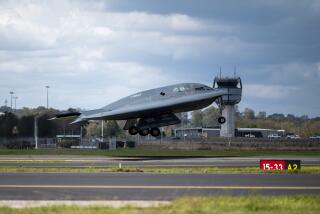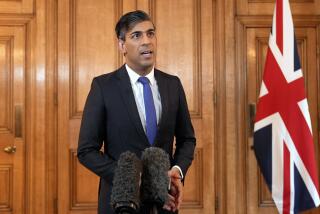U.S. Steps Up Strikes as Target List Grows
- Share via
WASHINGTON — The U.S. bombing campaign against Afghanistan intensified sharply Monday amid signals from the Pentagon that the air raids will not taper off soon, as some officials suggested only a few days ago.
As Navy attack planes and land-based bombers blasted targets across Afghanistan, Pentagon officials said Monday’s strikes may have been even larger than on the campaign’s first day, when 40 aircraft and 50 cruise missiles were dispatched against the Taliban regime and Osama bin Laden’s Al Qaeda terrorist network.
“It’s been a big day for the air war,” a senior defense official said.
Meanwhile, a leader of the anti-Taliban Northern Alliance said in an interview that about 10,000 rebel fighters were advancing on the strategically important city of Mazar-i-Sharif in northern Afghanistan and expect to take it in the coming days.
The city’s capture would help the rebel forces consolidate groups of fighters who have been battling in separate pockets in the north and west.
U.S. forces began the air campaign Oct. 7 to root out Bin Laden--the Bush administration’s top suspect in the Sept. 11 attacks on New York and the Pentagon--and to punish the Taliban for harboring him.
Defense Secretary Donald H. Rumsfeld told reporters that although the air campaign’s planners had largely destroyed their first list of targets, they have developed a new list with the help of overhead surveillance cameras and sources on the ground.
U.S. officials also hope that “as relationships with people on the ground develop and improve . . . the targeting information will be still better,” he added.
Lasting through the night and into daybreak Monday, the latest airstrikes pounded Kabul, the capital, and its airport, where a variety of military equipment has been stored. The bombs cut a power cable, plunging the city into darkness, and sent residents fleeing.
Ammunition storage depots north of Kabul and in Kandahar were targeted, as were terrorist camps, Associated Press reported.
Officials also said they are finding signs that the Afghan regime and its allies have, through great efforts, managed to conceal more weaponry than U.S. forces had realized.
Rumsfeld and Air Force Gen. Richard B. Myers, chairman of the Joint Chiefs of Staff, described how an American bomb had struck a cave complex in Karam in the hills of eastern Afghanistan near Jalalabad that apparently held a large arsenal of weapons and ammunition.
Taliban officials have contended that U.S. forces killed 200 civilians at the town. But U.S. defense officials say any deaths were caused by secondary explosions triggered when a bomb aimed at the cave ignited the arsenal.
While officials acknowledged that their intelligence on the cave’s interior is limited, the fact that it burned for up to four hours shows that it contained an extensive cache of weapons, they said.
“They were not cooking cookies inside those tunnels,” Rumsfeld said. “Let’s face it, you do not spend that kind of money, and dig that far in, and store that many weapons and munitions that would cause that kind of sustained secondary explosions, unless you have very serious purposes for doing it.”
He added that any people in the vicinity who were killed or injured “were clearly connected to those activities.”
In the opening week of the air campaign, some independent analysts questioned why the Taliban seemed to leave so many aircraft in the open where they could be struck by U.S. forces. They have suggested that some of the aircraft might have been decoys, or simply beyond repair.
On Friday, a senior Defense Department official told a group of reporters than the Afghan regime apparently had learned little from Serb and Iraqi forces, who learned to conceal their heavy weaponry.
But Rumsfeld insisted that the Taliban has made an effort to hide its equipment, and asserted that the location of many planes and helicopters may be unknown to the U.S. for that reason.
“I would go so far as to say that I’m confident that they have both planes and helicopters that we’ve not found that we don’t know exist,” he said.
Last week, senior defense officials said the initial bombing phase of the campaign would last a week or less and would be followed by a period in which the bombing slowed and special operations forces began a ground search for targets. But Rumsfeld suggested that the pace of bombing was not about to change.
Reporters asked Rumsfeld about a comment from the captain of the U.S. aircraft carrier Enterprise, who said Sunday that U.S. warplanes were now in a “cleanup mode.” Asked whether his view or the captain’s was the most accurate description of what would happen next, Rumsfeld said emphatically, “Go with me!”
Rumsfeld also sought to rebut suggestions that the U.S. was avoiding strikes on Taliban forces north of Kabul to prevent the Northern Alliance from sweeping into the capital and taking control before Afghan political leaders can decide on a successor government.
He said U.S. forces have had “less than perfect targeting information” about the Taliban forces, which are well entrenched. But he added, “I suspect that in the period ahead, that’s not going to be a very safe place to be.”
The U.S. also began dropping leaflets from aircraft in some parts of the country Monday. They show a picture of a uniformed U.S. service member shaking hands with an Afghan; the accompanying text says that an international coalition has come to help the country.
On the aircraft carrier Carl Vinson in the Arabian Sea, pilots reported Monday that their missions increasingly have turned from leveling major targets such as airports to destroying tanks, equipment and roads. The planes are dropping fewer bombs on fixed, or “hard,” targets. Instead, U.S. pilots are searching for more elusive “emerging” targets: troops, tanks and communications systems.
“We clearly have air supremacy,” Rear Adm. Thomas E. Zelibor said Monday. “Now we’re focused on preparing the battlefield. We want to make sure we have a clear area.”
A 30-year-old fighter pilot named Corie said he spent Monday flying over desolate Afghanistan outback, snapping photographs of military bases and roads. “We’re just trying to get an idea what’s going on,” said the St. Louis native.
In Uzbekistan, meanwhile, Mohammed Hashad Saad, the top Northern Alliance official based in that country, said that if the opposition force takes Mazar-i-Sharif and the territory to the north, he expects Uzbekistan’s government will reopen the Friendship Bridge, which spans the Amu Darya river between the two nations.
The bridge could provide an important route for supplying the anti-Taliban forces. Mazar-i-Sharif is just an hour by car from the southern Uzbek city of Termez, on the bridge’s northern end. The bridge, built by the Soviet Union in the 1980s to aid its invasion of Afghanistan, has been closed since the Afghan city fell to the Taliban in 1997.
The main commander of the alliance troops nearing Mazar-i-Sharif is Ata Mohammed, who has 5,000 soldiers under his command, Saad said. The Northern Alliance forces are about 35 miles from the city by road--or 12 miles over the rugged mountains, he said.
*
Richter reported from Washington and Paddock from Tashkent, Uzbekistan. Times staff writer Megan K. Stack aboard the Carl Vinson contributed to this report.
More to Read
Sign up for Essential California
The most important California stories and recommendations in your inbox every morning.
You may occasionally receive promotional content from the Los Angeles Times.











